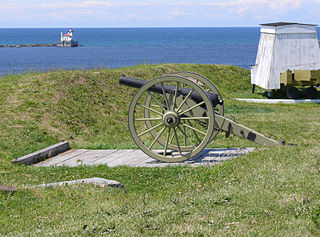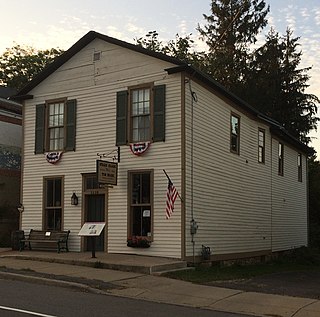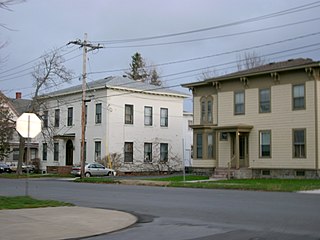
The Erie Canal is a canal in New York, United States that is part of the east–west, cross-state route of the New York State Canal System. Originally, it ran 363 miles (584 km) from where Albany meets the Hudson River to where Buffalo meets Lake Erie. It was built to create a navigable water route from New York City and the Atlantic Ocean to the Great Lakes. When completed in 1825, it was the second longest canal in the world and greatly affected the development and economy of New York, New York City, and the United States.

Liverpool is a lakeside village in Onondaga County, New York, United States. Its population was 2,347 at the 2010 census. The name was adopted from the city of Liverpool in the United Kingdom. The village is on Onondaga Lake, in the western part of the town of Salina and is northwest of Syracuse, of which it is a suburb.

Fulton is a small city in the western part of Oswego County, New York. The population was 11,896 as of the 2010 census. The city is named after Robert Fulton, the inventor of the steamboat.

Mexico is a town in the northeast part of Oswego County, New York, United States. The population was 5,197 at the 2010 census. The town contains a village also named Mexico.

Fort Ontario is an American historic fort situated by the City of Oswego in Oswego County, New York. It is owned by the state of New York and operated as a museum known as Fort Ontario State Historic Site.

The New York State Canal System is a successor to the Erie Canal and other canals within New York. Currently, the 525-mile (845 km) system is composed of the Erie Canal, the Oswego Canal, the Cayuga–Seneca Canal, and the Champlain Canal. In 2014 the system was listed as a national historic district on the National Register of Historic Places in its entirety, and in 2016 it was designated a National Historic Landmark.

Oswego Harbor West Pierhead Lighthouse is an active aid to navigation located off the coast of Oswego, New York. It was built in 1934 to replace an earlier light constructed in 1880. It stands at the end of a 2,000-foot-long (610 m) breakwater at mouth of Oswego River, extending .5 miles (.8 km) out onto Lake Ontario. It is accessible by boat or from land over the abutting breakwater. It is not open to the public. It is owned by the City of Oswego and operated by the United States Coast Guard. It is listed on the National Register of Historic Places.

The H. Lee White Marine Museum is located in Oswego, New York. It was founded in 1982 by Rosemary Sinnett Nesbitt (1924-2009), a local professor and the City of Oswego Historian. Nesbitt retired from directorship of the museum in 2008 after completing 25 years of service.

Williamsbridge Reservoir was a natural lake measuring 13.1 acres (5.3 ha) just south of Van Cortlandt Park in the Bronx, New York. Specifically the body of water was located at 208th Street and Bainbridge Avenue. It was shaped like a saucer and was normally 41 feet (12 m) deep. Its water level dropped approximately 14 feet (4.3 m) in mid-August 1901. On April 3, 1934 Commissioner of Water Supply, Gas and Electricity, Maurice P. Davidson, proposed that it be offered to Robert Moses to be used as a park site. The reservoir had ceased to be used after 1919.

Day Peckinpaugh is a historic canal motorship berthed at the Matton Shipyard on Peebles Island, Cohoes in Albany County, New York.

Andrew Jackson Warner, also known as A. J. Warner, was a prominent architect in Rochester, New York.

The Oswego–Oneida Streets Historic District is a national historic district located at Baldwinsville, Onondaga County, New York. The district encompasses 32 contributing buildings on 50 acres (20 ha)s in a residential section of Baldwinsville. The district developed between about 1830 and 1920 and includes notable examples of Greek Revival, Italianate, and Gothic Revival residential architecture.

Oswego Armory is a historic National Guard armory located at Oswego in Oswego County, New York. It is a brick and stone castle-like structure built in 1906–1908. It was designed by State architect George L. Heins. It consists of a 2 1⁄2-story administration building with an attached large, gable-roofed drill shed. The building features a 5-story octagonal tower at the northwest corner.

St. James' Church is a historic Episcopal church located at Cleveland in Oswego County, New York. It is a frame Gothic Revival style structure built in 1867. It is a 28-by-70-foot rectangular board and batten building composed of a nave, front entry, chancel, and tower which rests on a random coursed stone foundation.

Fort Brewerton is a historic fort site located at Brewerton in Oswego County, New York. It is the site of a fort that originally was in the form of an eight-pointed star with sixteen 30-foot (9.1 m) faces surrounded by a 10-foot (3.0 m) moat. The 480-foot-long (150 m) parapet had earth walls 5 feet (1.5 m) high from which projected log palisades. Within the parapet were four log blockhouses, smaller buildings for munitions and supplies, and wells. It was erected in 1759 to defend the passage from Albany to the port of Oswego.

Richardson-Bates House is a historic home located at Oswego in Oswego County, New York. It is constructed primarily of brick and built in two stages. The main section is a 2 1⁄2-story, Tuscan Villa style brick residence with a gable roof and 4-story tower designed by architect Andrew Jackson Warner about 1867. The interior features carved woodwork by Louis Lavonier. The South wing addition included a private library, formal dining room and kitchen that was completed in 1889.

Starr Clark Tin Shop is a historic commercial building located at Mexico in Oswego County, New York. It is a two-story wood-framed vernacular building built about 1827 with Federal details. The tin shop measures 24 feet 4 inches (7.42 m) wide and 32 feet (9.8 m) deep, with a 24-foot-4-inch-wide by 25-foot-8-inch-deep rear wing. Its owner, Starr Clark, was a widely recognized abolitionist and supporter of the Underground Railroad.

State Street Methodist Episcopal Church, now known as State Street United Methodist Church, is a historic Methodist Episcopal church located at Fulton in Oswego County, New York. The original section was built in 1894, and expanded in 1900 with the addition of an auditorium in the Akron Plan. It consists of a one-story auditorium with 1 1/2-story education. A basement was added in 1906, and two-story wing in 1962. The church is constructed of red brick and is in the Romanesque style. It has a slate cross-gable roof and two asymmetrical towers. The larger bell tower is four stories tall and contains two levels of stained glass windows.

Kingsford Historic District is a national historic district located at Oswego, Oswego County, New York. It encompasses 76 contributing buildings in a predominantly residential section of Oswego. It developed between about 1830 and 1910, and includes notable examples of Italianate, Romanesque Revival, Colonial Revival, and Tudor Revival style architecture. Located in the district is the separately listed Kingsford House. Other notable buildings include the former St. Matthew's Lutheran Church (1888), 40 West Oneida Street (1898) designed by Claude Fayette Bragdon, the former Public School #3 (1860s), and West Baptist Church (1867) designed by Andrew Jackson Warner.

























